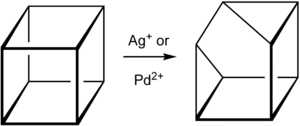楔形烷
外觀
| 楔形烷 | |
|---|---|

| |

| |
| IUPAC名 Pentacyclo[3.3.0.0 2,4.03,7.06,8]octane 五環[3.3.0.0 2,4.03,7.06,8]辛烷 | |
| 識別 | |
| CAS號 | 20656-23-9 |
| PubChem | 140734 54749138(2R,4R,6R,8R) 11194301(2S,4S,6S,8S) |
| ChemSpider | 124127 |
| SMILES |
|
| 性質 | |
| 化學式 | C8H8 |
| 摩爾質量 | 104.06 g·mol⁻¹ |
| 密度 | 1.578 g/ml |
| 熔點 | -22.19°C |
| 沸點 | 137.895°C |
| 危險性 | |
| 閃點 | 7.646°C |
| 若非註明,所有數據均出自標準狀態(25 ℃,100 kPa)下。 | |
楔形烷(英語:Cuneane)是一種飽和的環烷烴,化學式為C8H8。其英文名由拉丁文「cuneus」衍生,意為「楔子」。[1]
楔形烷是立方烷的價鍵異構體[2]。楔形烷的衍生物中,某些還具有液晶的性質[3]。
製備
[編輯]楔形烷可以由立方烷經由金屬離子催化的σ遷移反應來製備[4][5],如Ag+與Pd2+均可催化此反應;直接加熱亦可[2]。 該反應是一個放熱反應[6],因為楔形烷的張力能比立方烷小[2]。 同樣的反應也發生在高立方烷(C9H10)以及雙高立方烷(C10H10)上。[7][8]

圖一:金屬離子催化的從立方烷到楔形烷的合成
幾何特性
[編輯]
在楔形烷中存在着三組化學環境相同的碳原子(下圖中的A,B,C),這也已經被NMR方法所證實[9] 。化學環境相同的氫原子也有三組[2]。楔形烷的碳骨架的分子圖是一個正則圖,並具有三組不等效的頂點。因此它也是數學化學中重要的測試不同算法的測試物。[10][11]
類似的幾何結構還出現在其他化合物中。如[Ni8(L14Naph)12](BF4)16這一配合物中,陽離子中的8個鎳原子的相對位置就與楔形烷中碳原子的空間位置相同。[12]
參見
[編輯]參考資料
[編輯]- ^ R. Criegee, R. Askani. Octamethylsemibullvalene. Angewandte Chemie International Edition in English. 1968, 7 (7): 537. doi:10.1002/anie.196805371.
- ^ 2.0 2.1 2.2 2.3 2.4 薛價猷. (CH)n多面体烷的合成与结构. 化學通報. 1985, (2): 31-39.
- ^ Bényei, Gyula; Jalsovszky, István; Demus, Dietrich; Prasad, Krishna; Rao, Shankar; Vajda, Anikó; Jákli, Antal; Fodor‐Csorba, Katalin. First liquid crystalline cuneane‐caged derivatives: a structure-property relationship study. Liquid Crystals. 2006, 33 (6): 689–696. doi:10.1080/02678290600722940.
- ^ Michael B. Smith, Jerry March. March’s Advanced Organic Chemistry 5th. John Wiley & Sons, Inc. 2001: 1459. ISBN 0-471-58589-0.
- ^ Philip E. Eaton, Luigi Cassar, Jack Halpern. Silver(I)- and palladium(II)-catalyzed isomerizations of cubane. Synthesis and characterization of cuneane. Journal of the American Chemical Society. 1970, 92 (21): 6366–6368. doi:10.1021/ja00724a061.
- ^ Maria Victoria Roux,Juan Z. Da´valos. Cubane, Cuneane, and Their Carboxylates: A Calorimetric Crystallographic, Calculational, and Conceptual Coinvestigation. J. Org. Chem. 2005. doi:10.1021/jo00408a041.
- ^ Leo A. Paquette and John C. Stowell. Silver ion catalyzed rearrangements of strained .sigma. bonds. Application to the homocubyl and 1,1'-bishomocubyl systems. Journal of the American Chemical Society. 1970, 92 (8): 2584–2586. doi:10.1021/ja00711a082.
- ^ W. G. Dauben, M. G. Buzzolini, C. H. Schallhorn, D. L. Whalen, K. J. Palmer. Thermal and silver ion catalyzed isomerization of the 1,1′-bishomocubane system: preparation of a new C10H10isomer. Tetrahedron Letters. 1970, 11 (10): 787–790. doi:10.1016/S0040-4039(01)97830-X.
- ^ H. Guenther and W. Herrig. Anwendungen der 13C-Resonanz-Spektroskopie, X. 13C,13C-Kopplungskonstanten in Methylencycloalkanen. Chemische Berichte. 1973, 106 (12): 3938–3950. doi:10.1002/cber.19731061217.
- ^ M.I. Trofimov, E.A. Smolenskii. Electronegativity of atoms of ring-containing molecules—NMR spectroscopy data correlations: a description within the framework of topological index approach. Russian Chemical Bulletin. 2000, 49 (3): 402. doi:10.1007/BF02494766.
- ^ M.I. Trofimov, E.A. Smolenskii. Application of the electronegativity indices of organic molecules to tasks of chemical informatics. Russian Chemical Bulletin. 2005, 54 (9): 2235. doi:10.1007/s11172-006-0105-6.
- ^ Stephenson, Andrew; Michael D. Ward. An octanuclear coordination cage with a ‘cuneane’ core—a topological isomer of a cubic cage. Dalton Transactions. 2011, (40). doi:10.1039/C0DT01767A.
外部連結
[編輯]- 2D and 3D Models of Dodecahedrane and Cuneane Assemblies Link


